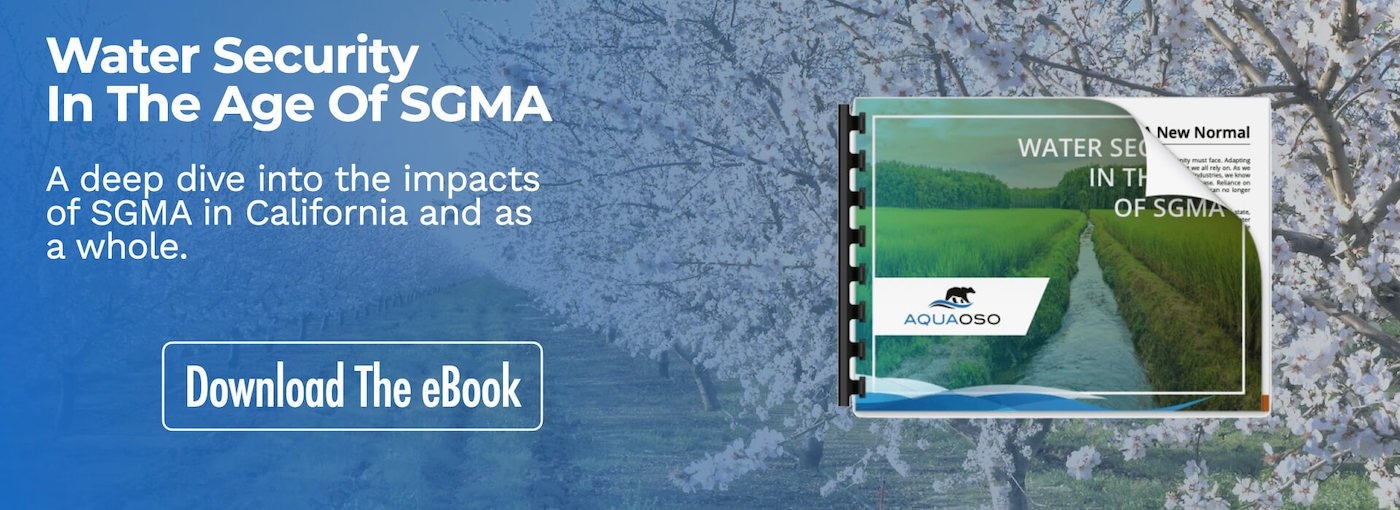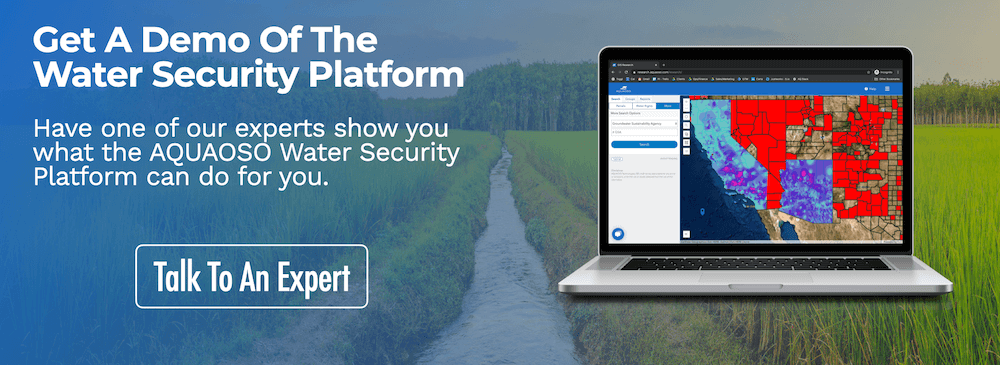Water Scarcity and Agriculture Trends for 2021
Part of our Water Trends Guide
What trends can we expect to see concerning water scarcity and agriculture in 2021? Every 10 years, the U.S. Forest Service conducts an assessment under the Resources Planning Act of the state of renewable resources in the U.S. Their most recent findings suggest that water scarcity in agriculture is going to be one of the key issues we’ll face in the near future, especially in some of the most overstressed watersheds:
“By 2071, nearly half of the 204 freshwater basins in the United States may not be able to meet the monthly water demand.”
They base this projection on two trends. The first is an increase in population, both in the U.S. as a whole and particularly in states that are already facing water shortages, such as California and Texas. Second is a reduced supply of water due to changes in rainfall patterns and evaporation, largely caused by climate change.
Not all basins will require drastic measures to reach sustainability, and “reducing water use for irrigation by just 2% could prevent shortages in a third of these basins.” Others would require a 30% reduction in order to meet targets. Regardless, water shortages are likely to hit agriculture hardest unless conservation measures are taken.
With this picture in mind, let’s take an in-depth look at what’s on the horizon and how we can not only react, but be proactive to water trends.
Climate Change, Water Scarcity, and Agriculture
While water conservation in agriculture encompasses a wide variety of technologies and practices, we can get a sense of what’s ahead by looking at some hard data. According to the American Geophysical Union’s “Adapting To Future Water Shortages” report, the way to think about the relationship to climate change is as follows:
In projecting future water demand, we assume that the declining past trends in water use rates will continue, although at a gradually attenuating rate as the practical limits of adaptability in the various sectors are approached. From 2010 to 2060, for example, if the climate were to remain stable, we project that aggregate U.S. withdrawal per capita would fall by 25% and that total withdrawal would increase by only 8% despite a population increase of 44%. The 25% drop in overall withdrawal rate reflects projected reductions in withdrawal rates in all major water use sectors.
Projected changes in climate will affect water use in several sectors (Georgakakos et al., 2014; Parry et al., 2007), as rising potential evapotranspiration rates, plus decreasing precipitation in some areas, raise agriculture and landscape irrigation demands and rising temperatures raise electricity demands. Based on modeling the effects of climate change on water use in the domestic and public, thermoelectric, and agricultural sectors, and averaging across the 14 different climate futures considered here, we project that aggregate U. S. withdrawal per capita will fall from 2010 to 2060 by 16%—thus, at substantially lower rates of decline than without climate change—and desired total withdrawal will increase by 22%. As with water yield, there is substantial variation across the different climate futures; for example, the change in projected U.S. desired total withdrawal ranges across the futures from 16% to 32%. Of course, the increases would be higher in the absence of the assumed declines in water use rates.
Essentially, we’ll have to continue to be be aware of the impacts of climate change on particular regions as well as find new ways to address the link between water stress and agriculture impacted by climate change. Awareness (quantifiable and measurable awareness) will be critical in order to keep future water demand at sustainable levels.
The Praia Commitment
In 2019, the International Forum on Water Scarcity in Agriculture released a document called the Praia Commitment, which contains 17 policy recommendations by over 200 policymakers and scientists. These include:
- “More nutrition per drop”: With water consumption varying widely from crop to crop, securing water for food production means being more selective about the crops we invest in. The Food and Agriculture Organization of the U.N. reports that “moving towards healthy diets that include sustainability considerations would reduce the water footprint of diets … [by] 18%.”
- Living with salinization: Salinization occurs when salts build up in the soil, due to poor irrigation and soil management practices or to natural causes. While the FAO reports that only .2% of soils in North America are saline, up to 62 million hectares are affected globally, with 2,000 additional hectares lost daily.
In the U.S., the San Joaquin Valley, as well as parts of the Colorado River Basin, are at risk, with an economic impact of over $750 million. Proposed ways to “live with salinity” include planting salt-tolerant crops and developing saline farming systems that incorporate agrobiodiversity.
- Better data on water resource availability: The Praia Commitment calls for a “one-stop-shop [to] provide policymakers with guidelines and tools to appreciate the impacts of technology choices and investment decisions.” They also call for taking a “proactive and risk-based approach to drought preparedness.” Our Water Security Platform is one example of this kind of resource.
Watershed Agreements
Because many watersheds cross state lines, state water laws are sometimes not enough to ensure sustainable water use. According to the Watermark Initiative,
“Over 95 percent of the available freshwater resources in the United States are interstate in nature and governed by interstate water compacts.”
Currently, there are 27 interstate compacts, covering many regions of the U.S. But while many of these agreements have been in place for decades, some of them may have to be renegotiated as supply and demand changes due to climate change.
Additionally, “the most significant aquifers in the U.S. are interstate in scope,” although “states have not yet used interstate compacts to manage them.”
The Colorado River Basin is among the most severely-stressed watersheds, with seven states depending on its water for domestic and agricultural use: “As a result of reduced snowpack, streamflow in the Colorado River is expected to decrease significantly in the 21st century, with predicted reductions of as much as 45 percent by 2050.”
Trends in Water Markets
Water trading has become one of the most promising strategies for mitigating water risk, by allowing buyers and sellers to make cost-effective water deals within their basin. But water trading varies widely from state to state, and only some areas have implemented smart water markets with the capacity for algorithmic matching. Let’s take a look at the most recent water trading trends for two key water-stressed states:
Arizona
Arizona’s water trading market accounts for about 4% of its annual consumptive water use, with 8% categorized as permanent sales and 92% as leases. Between 2009 and 2018, around 151,000 acre-feet were traded each year, with prices increasing 1.40% over that timeframe. Permanent sales were priced at around $2046/AF, while leases were priced at around $130/AF, or 6% of the sale price.
California
California’s water system is notable for the “geographic mismatch between the sources of supply and the bulk of demand,” which requires extensive storage and transportation infrastructure to maintain. Around 60% of the state’s water supply consists of surface water, with groundwater accounting for 22% and wastewater for 18%.
Between 2009 and 2018, leases accounted for 1.1 million acre-feet per year, around 2% of California’s total water allocation of 61 MAF. During the 2015 drought, sales reached a high of $800 million, compared to $300 million in 2018, or $277/AF.
What Can Be Done
It can be common to assume that these macro trends are too big for any one grower, lender, or investor to be able to make a difference and that it’s better to leave it up to regulators and conservationists to address the problem. But we think that by understanding and sharing data and ideas, we all – people and professionals working collaboratively – play a role in contributing to the positive changes we need.
After all, knowing what trends are on the horizon is one thing, but acting on these trends and taking steps toward water resilience is what matters. As the Praia Commitment puts it:
“Overcoming these challenges will require espousing a holistic and multi-dimensional approach…” And, “there is a need for innovation platforms bridging the gap between researchers, innovators, and users, so as to identify and address bottlenecks.”
By collecting and sharing data on water use, pricing water risk directly into loans and land deals, and participating in smart water markets, we can work across disciplines and industries to develop more resilient strategies in agriculture.
You can read more about important current trends in our Water Trends Guide.
The Bottom Line
At AQUAOSO, we feel that our biggest contribution to water conservation is data. Our unique Water Security Platform serves as a “one-stop-shop” for lenders, investors, and other stakeholders to assess the water risk of a particular region or parcel of land and make better investments and growing decisions.
We help our customers get a macro and micro view of major trends, by providing data on water rights, water risk, and water regulations all in one place.
Find out more about the regions we serve or contact us today to learn more about our platform or request a free demo!
Recent Posts
New Groundbreaking Trends In Data Management In Banking
With each passing year, technology introduces new methods of revolutionizing the way society handles data. But with a seemingly immeasurable amount of data being collected, it can be hard for financial professionals to make the best use of the information they already...
The Benefits of Interactive Data Visualization In Ag Finance
Recent years have presented new factors that necessitate that due diligence to extend beyond traditional metrics. Extreme weather events like Derechos, wildfires, and droughts are now frequent local phenomena that must be incorporated into lending risk management. ...
How to Identify and Mitigate Ag Finance Risk Using a Data Management Platform
Ag finance has no shortage of risk. Any ecological, regulatory, or social factor that impacts harvests ultimately impacts portfolio returns. Anticipating and mitigating loss scenarios is key to remaining competitive in the volatile 21st-century marketplace. Perhaps...






